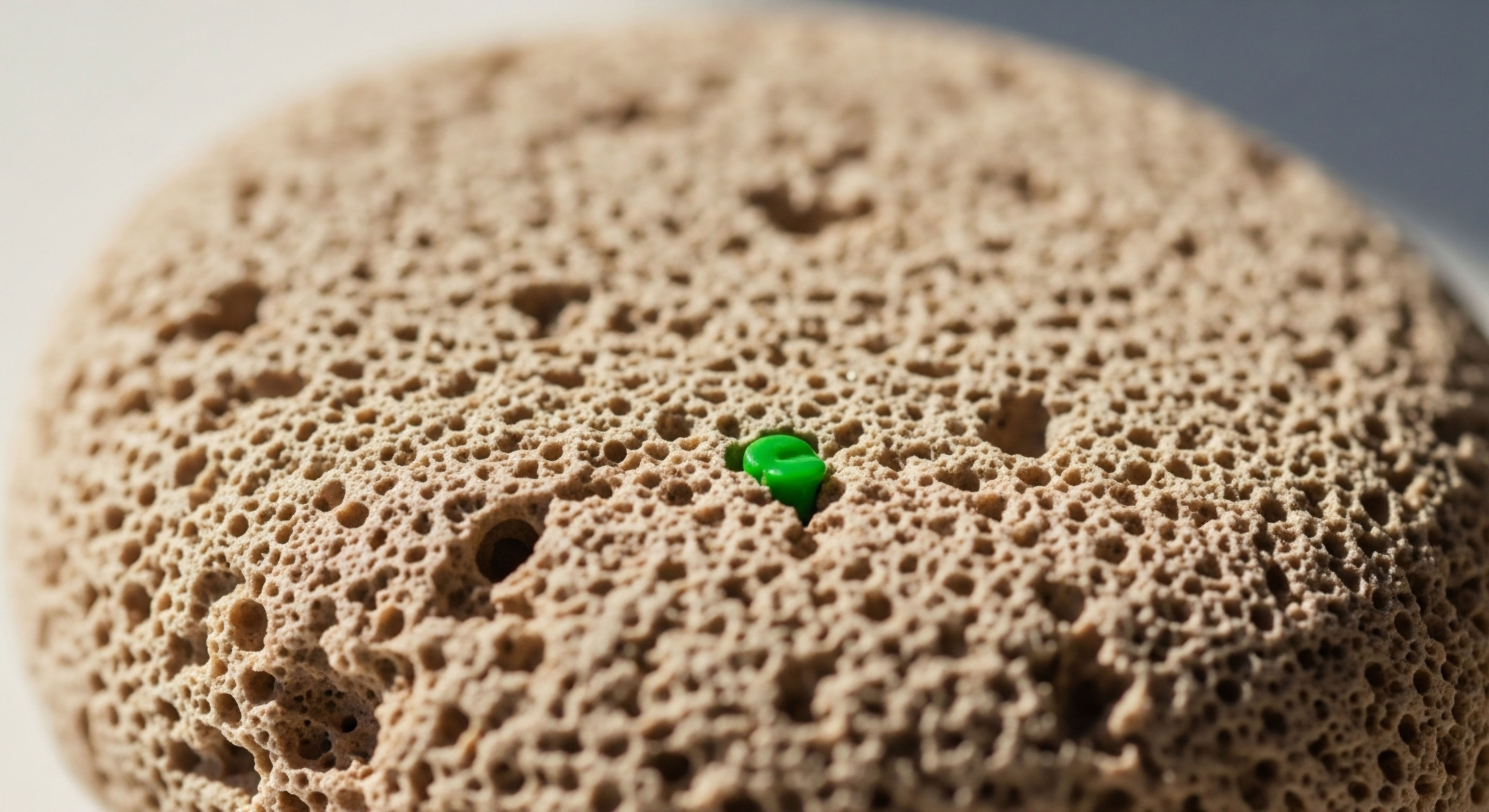

Fundamentals
When your body experiences a persistent ache, a lingering stiffness, or a wound that seems to take an eternity to mend, it is natural to feel a sense of frustration, perhaps even a quiet concern. This experience is not uncommon; many individuals encounter moments when their physical resilience appears diminished, when the body’s inherent capacity for repair feels compromised.
You might wonder why a seemingly minor injury, such as an injection site, continues to bother you long after it should have resolved. This enduring discomfort often signals a deeper biological narrative, one where the body’s intricate communication systems are attempting to convey an imbalance.
The sensation of persistent irritation at a site of prior intervention, like an injection, can be a direct manifestation of what is known as chronic inflammation. Acute inflammation is a vital, protective response; it is the body’s immediate call to action, sending immune cells and healing factors to an injured area.
This initial surge is essential for clearing debris, fighting potential pathogens, and initiating the repair process. Think of it as the body’s rapid response team, arriving swiftly to address an immediate crisis.
However, when this protective mechanism extends beyond its necessary duration, transforming into a prolonged state, it becomes chronic. This sustained inflammatory activity, rather than aiding recovery, can actively impede it. The immune system, instead of returning to a quiescent state, remains on high alert, continuously releasing chemical messengers that, over time, can damage healthy tissues. This persistent cellular agitation can undermine the delicate processes required for complete tissue regeneration and functional restoration.
Chronic inflammation, a prolonged immune response, can hinder the body’s natural healing processes at sites of injury.
Understanding the long-term implications of this sustained inflammatory state on injection site healing requires looking beyond the immediate area. The body operates as a profoundly interconnected network, where local events can reverberate throughout systemic pathways. Hormonal health, for instance, plays a significant role in modulating inflammatory responses and tissue repair. Hormones, acting as the body’s internal messaging service, influence nearly every cellular process, including immune regulation and cellular regeneration.

What Is the Body’s Healing Process?
The body’s healing process unfolds in a series of overlapping stages, each orchestrated by a complex interplay of cellular and biochemical events. The initial phase, hemostasis, involves blood clotting to stop bleeding. This is rapidly followed by the inflammatory phase, where immune cells like neutrophils and macrophages clear damaged tissue and pathogens.
Subsequently, the proliferative phase begins, characterized by the formation of new tissue, including collagen deposition and the growth of new blood vessels. The final stage, remodeling, involves the maturation and reorganization of the new tissue, restoring strength and function.
When chronic inflammation takes hold, it can disrupt this finely tuned sequence. Instead of progressing efficiently through these stages, the healing process can become stalled or dysregulated. The continuous presence of inflammatory mediators can lead to excessive scarring, poor tissue quality, and a failure to fully restore the original tissue architecture. This can manifest as persistent tenderness, induration, or even discomfort at the injection site, long after the initial procedure.

How Hormones Influence Tissue Repair?
The endocrine system, a collection of glands that produce and secrete hormones, exerts a profound influence over the body’s capacity for repair. Hormones such as testosterone, estrogen, progesterone, and growth hormone are not merely regulators of reproductive function or metabolism; they are also potent modulators of immune responses and tissue regeneration.
For instance, adequate levels of testosterone are associated with reduced inflammation and improved wound healing outcomes. Conversely, hormonal imbalances can contribute to a pro-inflammatory state, making the body less efficient at resolving inflammation and repairing damaged tissues.
Consider the role of cortisol, a stress hormone. While acute spikes in cortisol can suppress inflammation, chronic elevation, often seen in states of prolonged stress, can lead to immune dysregulation and impaired healing. This highlights the delicate balance required within the endocrine system for optimal physiological function, including the ability to heal effectively.
When this balance is disturbed, the body’s capacity to resolve inflammation at an injection site, or any site of injury, can be significantly compromised, leading to enduring issues.


Intermediate
Understanding the foundational principles of inflammation and hormonal influence sets the stage for exploring specific clinical protocols designed to optimize the body’s healing capacity and mitigate the long-term implications of chronic inflammation at injection sites. Personalized wellness protocols often address systemic imbalances that contribute to persistent inflammatory states, thereby supporting more efficient tissue repair and overall vitality.
These interventions are not merely about symptom management; they aim to recalibrate the body’s internal systems, allowing for a more robust and adaptive physiological response.
When considering persistent issues at an injection site, a comprehensive assessment of hormonal status becomes paramount. For men experiencing symptoms of low testosterone, such as reduced energy, altered body composition, or diminished well-being, Testosterone Replacement Therapy (TRT) can be a significant intervention.
Low testosterone levels can contribute to a pro-inflammatory environment, making the body less adept at resolving local inflammation and repairing tissues. By restoring testosterone to optimal physiological ranges, TRT can help modulate inflammatory pathways and support cellular regeneration.

Testosterone Optimization for Men
A standard protocol for male hormonal optimization often involves weekly intramuscular injections of Testosterone Cypionate, typically at a concentration of 200mg/ml. This method provides a steady supply of the hormone, helping to stabilize levels and avoid the peaks and troughs associated with less frequent administration. The goal is to achieve physiological concentrations that support overall health, including metabolic function and inflammatory regulation.
To maintain the intricate balance of the endocrine system and preserve natural testicular function, additional medications are frequently incorporated. Gonadorelin, administered via subcutaneous injections twice weekly, stimulates the pituitary gland to release luteinizing hormone (LH) and follicle-stimulating hormone (FSH). This action helps to sustain endogenous testosterone production and preserve fertility, addressing a common concern for men undergoing TRT.
Optimizing testosterone levels in men can reduce systemic inflammation and improve tissue repair capabilities.
Another consideration is the potential conversion of testosterone to estrogen, a process mediated by the enzyme aromatase. Elevated estrogen levels in men can lead to undesirable side effects and may also influence inflammatory responses. To mitigate this, Anastrozole, an aromatase inhibitor, is often prescribed as a twice-weekly oral tablet.
This helps to block the conversion of testosterone to estrogen, maintaining a more favorable hormonal milieu. In some cases, Enclomiphene may also be included to further support LH and FSH levels, particularly when fertility preservation is a primary objective.
The precise dosage and combination of these agents are always individualized, based on comprehensive laboratory assessments and a thorough evaluation of the patient’s clinical presentation. The aim is to restore systemic balance, which in turn supports the body’s ability to resolve chronic inflammation at a local level, such as an injection site, and promote effective healing.

Hormonal Balance for Women
Women also experience hormonal fluctuations that can impact inflammatory responses and tissue health, particularly during peri-menopause and post-menopause. Symptoms like irregular cycles, mood changes, hot flashes, and diminished libido often signal shifts in estrogen, progesterone, and testosterone levels. For these individuals, targeted hormonal optimization protocols can be highly beneficial.
Testosterone Cypionate is often administered to women via subcutaneous injection, typically at a much lower dose, such as 10 ∞ 20 units (0.1 ∞ 0.2ml) weekly. This low-dose approach aims to restore physiological testosterone levels, which can positively influence energy, mood, body composition, and tissue integrity. The impact on inflammatory markers and healing capacity is a significant aspect of this therapy.
Progesterone is prescribed based on menopausal status, playing a vital role in balancing estrogen and supporting overall endocrine health. Its anti-inflammatory properties and role in tissue health are well-documented. For some women, Pellet Therapy, involving long-acting testosterone pellets, offers a convenient administration method. When appropriate, Anastrozole may also be used in women to manage estrogen levels, though this is less common than in men and depends on individual hormonal profiles.
The table below provides a comparative overview of key components in male and female hormonal optimization protocols:
| Protocol Aspect | Male Hormone Optimization | Female Hormone Balance |
|---|---|---|
| Primary Hormone | Testosterone Cypionate (IM) | Testosterone Cypionate (SubQ) |
| Dosage Range | Typically 200mg/ml weekly | Typically 0.1 ∞ 0.2ml weekly |
| Fertility Support | Gonadorelin, Enclomiphene | Not primary focus, but overall health supports |
| Estrogen Management | Anastrozole (oral) | Anastrozole (less common, for pellets) |
| Additional Hormones | None specified | Progesterone (oral/topical) |

Peptide Therapies for Healing
Beyond traditional hormonal interventions, specific peptide therapies offer targeted support for tissue repair and inflammation resolution. These short chains of amino acids act as signaling molecules, influencing various biological processes. For individuals seeking anti-aging benefits, muscle gain, fat loss, or improved sleep, Growth Hormone Peptide Therapy is often considered.
Peptides like Sermorelin, Ipamorelin / CJC-1295, Tesamorelin, and Hexarelin stimulate the body’s natural production of growth hormone, which is crucial for cellular regeneration and tissue repair. MK-677, an oral growth hormone secretagogue, also supports these processes.
For direct support of tissue repair and inflammation, Pentadeca Arginate (PDA) stands out. This peptide is specifically utilized for its capacity to aid in tissue repair, accelerate healing, and modulate inflammatory responses. Its application can be particularly relevant for persistent issues at injection sites, as it directly supports the cellular mechanisms involved in resolving inflammation and restoring tissue integrity.
Other targeted peptides, such as PT-141 for sexual health, also demonstrate the specificity with which these agents can address particular physiological needs, often with systemic benefits that contribute to overall well-being and the body’s capacity for self-regulation and repair.
- Growth Hormone Secretagogues ∞ Peptides like Sermorelin and Ipamorelin stimulate the pituitary to release growth hormone, supporting cellular repair.
- Tissue Repair Peptides ∞ Pentadeca Arginate (PDA) directly aids in healing and inflammation resolution at a cellular level.
- Metabolic Peptides ∞ Tesamorelin and Hexarelin can influence body composition and metabolic health, indirectly supporting a less inflammatory state.


Academic
The long-term implications of chronic inflammation on injection site healing extend into the intricate molecular and cellular landscapes of the human body, revealing a complex interplay between immune dysregulation, endocrine signaling, and tissue matrix integrity. A deep understanding of these mechanisms is essential for truly appreciating why some individuals experience persistent issues at sites of prior intervention, even when seemingly minor.
The body’s capacity for precise tissue regeneration is a testament to its sophisticated biological architecture, yet this architecture is vulnerable to sustained inflammatory insults.
At the heart of chronic inflammation’s detrimental effects on healing lies the persistent activation of immune cells and the continuous release of pro-inflammatory cytokines. Unlike the transient burst of mediators during acute inflammation, chronic states involve a sustained presence of molecules such as Tumor Necrosis Factor-alpha (TNF-α), Interleukin-6 (IL-6), and C-reactive protein (CRP).
These mediators, while initially protective, can become destructive over time, leading to cellular senescence, fibrosis, and impaired angiogenesis. The delicate balance between pro-inflammatory and anti-inflammatory signals is disrupted, favoring a catabolic environment that actively impedes the orderly progression of tissue repair.

Systemic Interplay of Hormones and Inflammation
The endocrine system is not merely a collection of isolated glands; it functions as a highly integrated network, with axes like the Hypothalamic-Pituitary-Gonadal (HPG) axis and the Hypothalamic-Pituitary-Adrenal (HPA) axis exerting profound regulatory control over immune function and inflammatory responses.
Chronic inflammation can directly impact these axes, leading to hormonal dysregulation, which in turn perpetuates the inflammatory cycle. For instance, sustained systemic inflammation can suppress the HPG axis, leading to reduced production of gonadal hormones such as testosterone and estrogen. These hormones possess significant anti-inflammatory and tissue-protective properties.
Consider the impact of chronic inflammatory signaling on the HPA axis. Persistent inflammatory cytokines can stimulate the adrenal glands to produce cortisol. While acute cortisol surges are anti-inflammatory, chronic elevation can lead to glucocorticoid resistance, where cells become less responsive to cortisol’s anti-inflammatory effects.
This creates a paradoxical situation where high cortisol levels coexist with ongoing inflammation, further impairing the body’s ability to resolve inflammatory processes at a local site, such as an injection wound. This feedback loop illustrates how systemic inflammation can undermine the very hormonal mechanisms designed to control it.
Chronic inflammation can disrupt the HPG and HPA axes, leading to hormonal imbalances that perpetuate inflammatory cycles.

Cellular Mechanisms of Impaired Healing
At the cellular level, chronic inflammation at an injection site can lead to several pathological outcomes. Fibroblasts, the cells responsible for producing collagen and extracellular matrix components, can become overactive, leading to excessive scar tissue formation rather than functional tissue regeneration. This process, known as fibrosis, can result in induration, reduced elasticity, and persistent discomfort at the site. The quality of the collagen laid down in a chronically inflamed environment is often inferior, lacking the organized structure of healthy tissue.
Furthermore, chronic inflammation can impair the migration and differentiation of stem cells and progenitor cells, which are essential for true tissue regeneration. The sustained presence of reactive oxygen species (ROS) and proteolytic enzymes, released by activated immune cells, can directly damage cellular components and the extracellular matrix, creating an environment hostile to repair. This continuous cellular assault can lead to a state of non-healing or chronic wound formation, even in seemingly minor injuries like injection sites.
The role of specific peptides, such as Pentadeca Arginate (PDA), in modulating these cellular processes is a compelling area of research. PDA, a synthetic peptide, has demonstrated properties that include promoting angiogenesis (new blood vessel formation), modulating cytokine expression, and enhancing fibroblast function in a manner conducive to organized tissue repair rather than fibrosis. Its ability to influence the cellular microenvironment at an injured site suggests a direct mechanism for mitigating the long-term effects of chronic inflammation.
The table below illustrates the cellular and molecular consequences of chronic inflammation on tissue healing:
| Cellular/Molecular Aspect | Acute Inflammation (Resolution) | Chronic Inflammation (Dysregulation) |
|---|---|---|
| Cytokine Profile | Transient pro-inflammatory, then anti-inflammatory | Sustained pro-inflammatory (TNF-α, IL-6) |
| Fibroblast Activity | Controlled collagen deposition for repair | Excessive, disorganized collagen leading to fibrosis |
| Angiogenesis | New vessel formation for nutrient supply | Impaired or aberrant vessel formation |
| Immune Cell Presence | Neutrophils, then macrophages (M1 to M2 shift) | Persistent macrophages (M1 phenotype), lymphocytes |
| Tissue Outcome | Functional tissue regeneration, minimal scarring | Fibrosis, poor tissue quality, persistent discomfort |

How Does Metabolic Health Influence Healing Outcomes?
Metabolic health is inextricably linked to inflammatory regulation and healing capacity. Conditions such as insulin resistance and dyslipidemia, common in modern populations, contribute significantly to systemic chronic inflammation. Adipose tissue, particularly visceral fat, is not merely an energy storage depot; it is an active endocrine organ that secretes numerous pro-inflammatory adipokines. These molecules contribute to a low-grade systemic inflammatory state, making the body less resilient to local inflammatory challenges.
When an individual with underlying metabolic dysfunction receives an injection, the local inflammatory response at the site can be exacerbated and prolonged by the pre-existing systemic inflammatory burden. This creates a challenging environment for proper tissue resolution.
Optimizing metabolic health through nutritional strategies, physical activity, and targeted interventions can significantly reduce systemic inflammation, thereby improving the body’s overall capacity to heal and resolve local inflammatory processes. This holistic perspective underscores the interconnectedness of all physiological systems in determining long-term health outcomes.

References
- Guyton, Arthur C. and John E. Hall. Textbook of Medical Physiology. 14th ed. Elsevier, 2020.
- Boron, Walter F. and Emile L. Boulpaep. Medical Physiology. 3rd ed. Elsevier, 2017.
- Chrousos, George P. “Stress and Disorders of the Stress System.” Nature Reviews Endocrinology, vol. 5, no. 7, 2009, pp. 374-381.
- Traish, Abdulmaged M. “Testosterone and Chronic Inflammation.” Current Opinion in Endocrinology, Diabetes and Obesity, vol. 22, no. 3, 2015, pp. 229-234.
- Snyder, Peter J. et al. “Effects of Testosterone Treatment in Older Men.” New England Journal of Medicine, vol. 371, no. 11, 2014, pp. 1016-1027.
- Miller, Karen K. et al. “Effects of Growth Hormone and Testosterone on Body Composition and Muscle Function in Healthy Older Men.” Journal of Clinical Endocrinology & Metabolism, vol. 89, no. 11, 2004, pp. 5491-5498.
- Goldstein, Irwin, et al. “Bremelanotide for Hypoactive Sexual Desire Disorder in Women ∞ A Randomized, Placebo-Controlled Trial.” Obstetrics & Gynecology, vol. 132, no. 6, 2018, pp. 1373-1380.
- Kushner, Robert F. and Caroline M. Apovian. Obesity ∞ Mechanisms and Clinical Management. 3rd ed. CRC Press, 2020.
- Wallace, E. A. and J. R. W. Miller. “Peptide Therapeutics in Wound Healing.” Advanced Drug Delivery Reviews, vol. 154-155, 2020, pp. 108-120.

Reflection
As you consider the intricate dance between inflammation, hormones, and the body’s capacity for repair, perhaps a deeper understanding of your own biological systems begins to take shape. The journey toward reclaiming vitality is not a linear path, nor is it a one-size-fits-all solution. It is a deeply personal exploration, guided by the unique signals your body provides and informed by a nuanced understanding of its underlying mechanisms.
This knowledge, far from being abstract, serves as a powerful tool for introspection. It invites you to listen more closely to your body’s whispers, to recognize that persistent discomfort or a slow healing process might be a call for systemic recalibration rather than isolated treatment. Your experience is valid, and the science provides a framework for understanding its origins.
The insights shared here are but a starting point, a compass guiding you toward a more informed dialogue with your healthcare providers. True well-being emerges from a partnership between your lived experience and evidence-based clinical wisdom. May this understanding serve as a catalyst for your continued pursuit of optimal health, empowering you to navigate your unique biological landscape with confidence and clarity.



